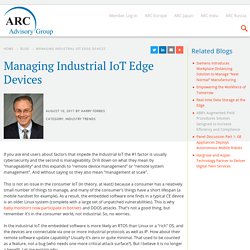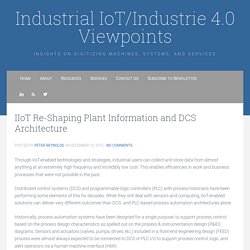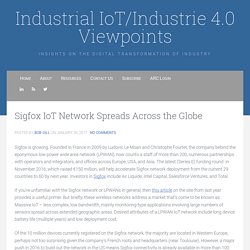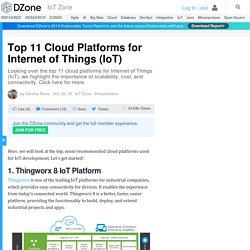

Managing Industrial IoT Edge Devices. If you ask end users about factors that impede the Industrial IoT the #1 factor is usually cybersecurity and the second is manageability.

Drill down on what they mean by “manageability” and this expands to “remote device management” or “remote system management”. And without saying so they also mean “management at scale”. This is not an issue in the consumer IoT (in theory, at least) because a consumer has a relatively small number of things to manage, and many of the consumer’s things have a short lifespan (a mobile handset for example). As a result, the embedded software one finds in a typical CE device is an older Linux system (complete with a large set of unpatched vulnerabilities).
This is why baby monitors now participate in botnets and DDOS attacks. In the industrial IoT the embedded software is more likely an RTOS than Linux or a “rich” OS, and the devices are connectable via one or more industrial protocols as well as IP. Make or Buy an IIoT platform? Edge Computing – Key Drivers and Benefits for Smart Manufacturing. 6 BEST PRACTICES IN INDUSTRIAL IOT ARCHITECTURE – Create a culture of innovation with IIoT World! IIoT Re-Shaping Plant Information and DCS Architecture - Industrial IoT/Industrie 4.0 Viewpoints. Through IIoT-enabled technologies and strategies, industrial users can collect and store data from almost anything at an extremely high frequency and incredibly low cost.

This enables efficiencies in work and business processes that were not possible in the past. Distributed control systems (DCS) and programmable logic controllers (PLC) with process historians have been performing some elements of this for decades. While they still deal with sensors and computing, IIoT-enabled solutions can deliver very different outcomes than DCS- and PLC-based process automation architectures alone. Historically, process automation systems have been designed for a single purpose; to support process control based on the process design characteristics as spelled out on the process & instrumentation design (P&ID) diagrams. For Industrial IoT, both the architecture and expected outcomes are very different. …… and of course the very nature of the enterprise is changing. Internet of Things-A Group. Sigfox IoT Network Spreads Across the Globe - Industrial IoT/Industrie 4.0 Viewpoints. Sigfox is growing.

Founded in France in 2009 by Ludovic Le Moan and Christophe Fourtet, the company behind the eponymous low power wide area network (LPWAN), now counts a staff of more than 200, numerous partnerships with operators and integrators, and offices across Europe, USA, and Asia. The latest (Series E) funding round in November 2016, which raised €150 million, will help accelerate Sigfox network deployment from the current 29 countries to 60 by next year.
Investors in Sigfox include Air Liquide, Intel Capital, Salesforce Ventures, and Total. If you’re unfamiliar with the Sigfox network or LPWANs in general, then this article on the site from last year provides a useful primer. But briefly, these wireless networks address a market that’s come to be known as Massive IoT – less complex, low bandwidth, mainly monitoring-type applications involving large numbers of sensors spread across extended geographic areas. Solutions 4.0 pour l'Industrie - Diota. The leading operating system for PCs, IoT devices, servers and the cloud. Getting Started With Windows IoT And Raspberry PI 3 ... IoT System Integrator Vendors. Internet of Things Apps. IoT Central – SaaS Platform Solution. Top 11 Cloud Platforms for Internet of Things (IoT)
Here, we will look at the top, most-recommended cloud platforms used for IoT development.

Let's get started! 1. Thingworx 8 IoT Platform Thingworx is one of the leading IoT platforms for industrial companies, which provides easy connectivity for devices. It enables the experience from today’s connected world. Thingworx is an IoT platform designed by PTC for development of enterprise app development. Easy connectivity with electronic devices, like sensors and RFIDs You can work remotely once you are done with the setup Pre-built widgets for the dashboard Remove Complexity of the project Integrated machine learning Pros Easy web page designs for customers Easy to manage devices Simple connectivity solutions Cons Difficult to use with custom programs in C# Hard to manage complex systems. 2.
Microsoft Azure provides multiple services to create IoT solutions. Azure IoT Suite provides features like: Easy Device Registry. Offers third-party services Secure and scalable High availability 3. 4. 5. 6. Sensor Analytics Solutions for Predictive Maintenance.